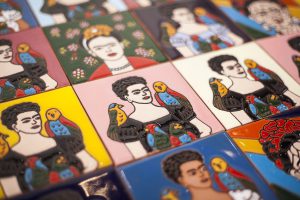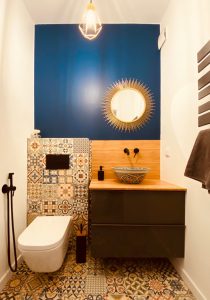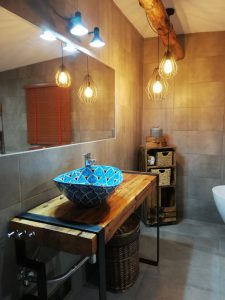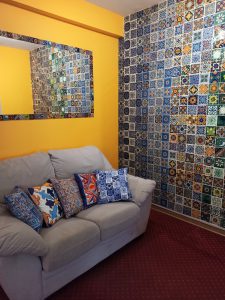Cerames has been providing customers with exceptional interior design products for years. The range includes handicrafts created by craftsmen from various regions of the world, including Morocco, Mexico, Poland and Tunisia. Cerames offers original and beautiful products, but at the same time practical and tested in use. The graphic side of the offer, but also the conceptual development of new designs and ready-made product sets is the responsibility of Julietta Torbus, creative manager. Julietta is a graphic designer, and she designs interiors as a hobby. She has been working at Cerames for several years, she knows the rules of the company and agreed to answer a few questions about her work.
Not at first. I saw an ad, I even went to the store's website, there were only products from Mexico. I found the product range to be great, it has an original artistic character and I thought it would be fun to work in a company like this. I was still very distant at the time, because I didn't even know if I would be invited for an interview. But it worked. When I first saw live products from our shop, love appeared 😉
I certainly don't care what products my job is about. I wouldn't be able to work in a company that sells harmful products that have a negative impact on human health, or sell very poor quality products, advertising them as something exclusive. Fortunately, products at Cerames do not belong to either category. What's more, they have something that immediately improves the mood. Maybe it's the colors, maybe a cheerful atmosphere... The artistic value of the products is more added, but it certainly makes work more enjoyable.
Mainly it is taking care of the company's image in terms of graphics. I help to create all kinds of banners, leaflets, graphic signs used both in print and in the Internet.
When an idea for a new product appears, e.g. Mexican tiles with Hucul patterns, I prepare a project which we send to our partners in Mexico. I also develop patchworks, i.e. ready-made compositions of different tiles, trying to combine the designs in the most harmonious way possible. Since we have a very harmonious team and everyone's opinion counts, everyone has a small contribution to make to most of what is happening in the company. I often only realize a jointly developed idea.
Yes, I like it very much, but unfortunately I am not a designer. Even I have such an affliction that when I am in some new room, I plan it in my mind so that it is functional and aesthetic - as if it were my home:). If I had to arrange a real apartment it would probably take me half my life. I would like to work out the smallest detail and choose the most appropriate option in my opinion. It's unrealistic, that's why I do something else 😉 When designing graphically, each time you can create something different and have a lot of fun.

These types of tiles, with their ascetic form, are great for any kind of interior. The Guadalajara Terracotta will perfectly combine Mexican tiles on the walls with the floor. It will also be a compromise for those who like the different colored Mexican tiles, but think it would be too much "madness" in their home to lay them on a larger surface.
The other terracotta tiles from Mexico are real classics. The colours will certainly warm up the interior, and their matt surface will give a subtle elegance. I think they will work well in the surroundings of now so popular shades of dark green, black or grey.
 Other new products available at Cerames are Mexican patchwork tiles and smaller decorative forms decorated with very colourful patterns. Can you tell where to use them best? Where will they fit? How to place them to make the interior look harmonious?
Other new products available at Cerames are Mexican patchwork tiles and smaller decorative forms decorated with very colourful patterns. Can you tell where to use them best? Where will they fit? How to place them to make the interior look harmonious?I will gladly tell you about the colourful Fridas patchwork. Fridas patchwork will work well in both glamorous and ascetic interiors. It all depends on how you use them. Even a single patchwork in the form of an image could be the main decoration and slightly break the raw, even industrial interior. Actually, a similar principle will work in case of all colourful and patterned Mexican patchworks. Mexican patchworks with floral or abstract motifs can also be successfully integrated into rustic or colonial space.
We have many different types of patchwork tiles. Cement patchwork is best suited for the floor. In this case it is very important to consider the thickness of the tiles at the design stage. Tiles have an additional layer of coloured cement in the mass, so even after decades of natural abrasion of the surface of the tile, the pattern on it remains unchanged and as clear as at the time of purchase. As a result of this technology, our cement tiles are slightly thicker than traditional stoneware tiles and it is necessary to take into account that there is no level difference. Cement tiles are suitable for any kind of room, so you can lay the floor with them even in the whole house. This is an additional advantage for small apartments, where a uniform floor will optically enlarge the connected interiors.
Speaking of wall tiles, Mexican patchwork deserves attention. They are in two versions - smooth and convex. In both cases, the tiles are glazed, which means they have a high gloss. Such tiles can visually enlarge the room. However, it should be remembered that they are richly ornamented, so they will fit more as decors in smaller rooms. If you decide on a uniquely impressive whole wall of Mexican tiles, remember to choose the one that is the shorter wall of your interior, preferably opposite the window. Such a position of a more accentuated wall will make the room seem more square.
The patterned tiles will also be perfect in the recesses. They will give the room depth and visually bring the wall on which they are located.

As far as the general rules for choosing tiles are concerned, for smaller rooms let's choose light colours and larger tile sizes. This will not make the interior look smaller. The fewer joints, the smoother and larger the surfaces appear.
If it is necessary to place some dark colour in a small room, let's use accessories in this colour.
In general, yes, I think so, but it depends on how many tiles we use and what style of room we have. If we have a small interior or the room style is completely different from our tiles (e.g. glamour) we can use them as accents. Then we should remember to choose the colors so that our interior is consistent.
By choosing light colours and shiny tiles we can optically enlarge the room.
By skillfully applying saturated colors we can visually change the shape of the room - for example, if we are wondering which wall to choose for a dark blue Mexican tile in a narrow room, let's choose the shorter one or the one opposite the entrance. A strong colour on one of the walls will also help to hide imperfections (e.g. incorrect proportions of the interior, refractions). When thinking about the colour of the interior, let's think about the leading colour. It can be complemented by up to 4 colours.
This is obviously not a rule, but I think that glazed Mexican tiles will balance matt surfaces very well. Before we lay our tiles in a bold color on a larger surface, let's think about how we will feel about this color, how it will affect our mood.
Yes, small tiles (5 to 30 cm) will work well on walls in larger rooms. We can also lay them on floors in small rooms, they can hide its imperfections. If our favourite tiles are from the small category and we don't have a large room, ask an expert if it is possible to lay them seamlessly. The fewer divisions, the larger the room is optically obtained. If there is no such possibility, let's choose a grout in the colour of the tile. On small surfaces, e.g. above the kitchen worktop, 10 x 10 cm tiles will be an ideal solution. However, the most important thing is that we feel that the tiles will fit inside and meet our expectations. What size of tiles we use is a secondary issue.

An artistic washbasin is best suited where its beauty will undoubtedly attract attention. If you go into the bathroom, the first thing you see is a beautiful patterned wash basin, you will achieve your designer's goal. These types of products are unique things worth boasting about.
It is good to pay attention to the shape of the washbasin. A larger washbasin will be more practical in everyday life. Counter top wash basins are also decorated on the outside, which makes them look bigger. Unfortunately, not every bathroom has enough space. We also need to remember to choose the right taller mixer for the wash basin. If we already have a leading colour in the bathroom, let's try to have the design and colour of the washbasin in such a way that the colour is harmonious with the whole.
We want the washbasin to be liked first and foremost, and not to be bored with its design.
I would also add the ease of cleaning to the selection criteria - certainly the smoother the surface, the easier the wash basin will be to clean. We'll also have less maintenance work with countertop washbasins.
Above all, we wanted customers to see our products in action. - as if they saw them in someone's apartment. We didn't have a place like this before. Everyone could come and look at our products, but had to imagine what they would look like inside. Now it's easier and you don't have to think. We just open the door of the living room and the customer sees the final effect immediately.
 Is there a place in the current office space where the customer should pay special attention? If so, why?
Is there a place in the current office space where the customer should pay special attention? If so, why?We wanted such a special place to be a corner with a wall of Mexican tiles. It's a place where clients can see live what Mexican patchwork on the wall looks like, but also sit down in a comfortable sofa, have a cup of coffee and think about the arrangement of their interior, compose their own patchwork on the table, or browse through various options. From this place you can also see the whole exposition in the living room and some calming greenery outside the window 😉
We cooperate with many architects, but it is best when the client comes with his designer, who already knows his needs and the room. Most of our products have a 3D object file, which designers can implement into their project. We make such files available free of charge.
In case of simpler projects, e.g. floors, we have our own software, which makes the design easier. It is so intuitive that customers can use it themselves and at home, create as many projects as they want. Of course, we are also happy to help with this kind of activities.
They would definitely be products from Mexico. One of the countertop washbasins for the bathroom, they're really impressive!
I also really like the Mexican patchwork made of small 5 x 5 cm tiles. But I don't have a specific idea for them. For now I have at home their substitute in the form of a mosaic of magnets on the fridge 😉
I would buy a copper lamp for the dining room or lounge. It already looks great on its own, but when on it gives the room an amazing character. Reflections of light reflected from copper give a unique warm, cosy atmosphere. It's like a winter evening in the mountains in a hut by the fireplace with a cup of mulled wine 😉